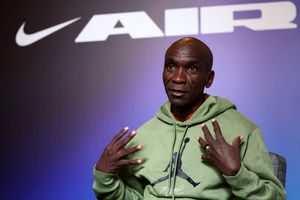
A Kenyan soldier patrols Burgabo in Somalia in November 2011.
| Jared Nyataya | Nation Media GroupPremium
Beyond enemy lines: Between the devil and the deep blue sea
What you need to know:
- After 47 years of diplomatic approach to peacebuilding, Kenya has for the past decade been involved in a very expensive war.
On the morning of October 16, 2011, Kenyans woke up to the news that the military had launched an offensive into southern Somalia called Operation Linda Nchi to pursue the Shabaab. A decade later, the Kenya Defence Forces (KDF) are yet to win the war.
On the positive side, Al-Shabaab cells in the country have been decimated. But in Somalia, their terror continues. Last Sunday, they killed 16 people at a beachside hotel in Mogadishu, a signal that the extremists are still well organised .
After 47 years of low-risk, non-interventionist approach to peace building, Kenya has for the past decade been involved in a very expensive war.
The Nation has returned to the Shabaab frontier to assess how the terror group has changed the ‘peace geography’ of the country – particularly the volatile border with Somalia. It’s a region that no journalists have ventured into for years.
The number of Kenyans killed in the Somali mission remains unknown but two significant raids on KDF troops left more than 100 soldiers dead. In the Battle of El Adde on January 15, 2016, the militants overran a Kenyan base after a 10-hour battle.
What looked like a punitive expedition against the series of kidnappings of tourists along the Kenya-Somalia border has snowballed into an intriguing international war – with various countries participating under the aegis of the African Union Mission to Somalia (Amisom), a peace keeping mission approved by the UN.
There’s no peace to be kept in Somalia. The mandate is peace enforcement.
Locally, Al-Shabaab raids have been contained. In six weeks, Kenya will be entering its 10th year since KDF entered Somalia. At the time, KDF said it was out to rescue a British tourist, Judith Tebbutt, and two other Europeans who were kidnapped from Daadab.
Ms Tebbutt was taken away from her hotel room in Lamu on the night of September 10, 2011 while Montserrat Serra and Blanca Thiebaut, both Spanish, were kidnapped on October 13, 2011. They were both working with Doctors Without Borders, an international medical non-governmental organisation.
While the three would be released months later following ransom payments by their families, Kenyan troops remained in the battle zone – and used the kidnappings as a justification to enter Somalia to deal with the militants.
Kenya later sought to carve a ‘buffer zone’ out of Somalia in Jubaland that would make it difficult for the militants to cross over. After four months of battle, KDF joined Amisom, which transferred the cost of the war from taxpayers to the UN.
“The Amisom mandate is not about peace-keeping. There’s no peace to be kept in Somalia. The mandate is peace enforcement,” then-Chief of Defence Forces Julius Karangi said.
Not yet
A decade later, the peace that General Karangi was talking about is yet to be realised. In between Kenya has had two military chiefs. President Uhuru Kenyatta, who succeeded President Mwai Kibaki, will serve his term with the troops still at war.
There have been hits and misses. Al-Shabaab, who initially targeted installations by foreign powers that had ‘issues with the Al-Qaeda’, turned their attention on Kenyans. Retaliatory attacks.
Their first happened at Westgate Shopping Mall on September 21, 2013 which killed 67. Since then, the terror group has carried out at least seven such large-scale attacks, killing over 600.
They demand is simple: Withdraw KDF troops from Somalia. However , with a lot still at stake, including geopolitical interests and national pride, the troops are unlikely to return home soon.
In the Nation series, we will explore the reasons behind Amisom’s failure to completely eliminate the Shabaab.
And for the first time, we will show Kenyans what it is like to live beyond enemy lines where you are trapped between the government on one side and extremist groups on the other. Finally, we will explain why Kenya is trapped in this terrorism mess and explore other ways out of the situation.






